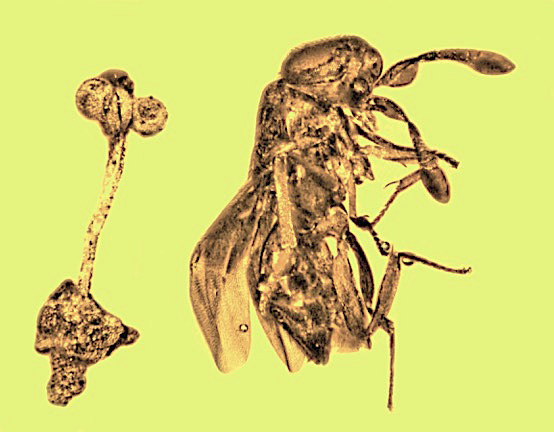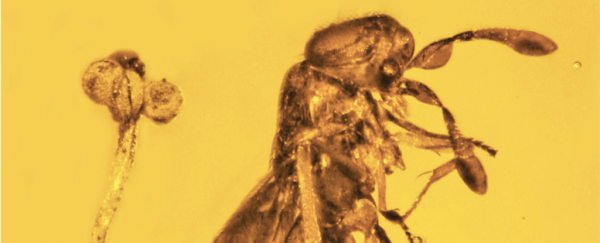A newly-discovered plant, a recently-discovered wasp, and a developing fly larva have been found trapped in amber, in an exquisitely-preserved moment of prehistoric ecology.
If the image of an insect trapped in amber seems familiar, you have George Poinar, Jr. – the entomologist who made this discovery – to thank. His early work extracting insect DNA from Dominican amber directly inspired the premise of Jurassic Park.
His latest study documents the first fossil record of the plant genus Plukenetia, and the first record of the plant genus on the Caribbean island of Hispaniola.
"Fossil flowers of members of this family are quite rare," said Poinar. "I could only find one previously known fossil, from sedimentary deposits in Tennessee."
The famed Dominican amber is a fossilized form of resin from the extinct Hymenaea protera tree, which scientists think once grew in a moist tropical forest ecosystem, based on the variety of life forms its resin entombed.
 (George Poinar, Jr., 2022, Historical Biology)
(George Poinar, Jr., 2022, Historical Biology)
This particular specimen was mined from la Cordillera Septentrional mountain range.
There is debate over the age of Dominican amber fossils, with conflicting theories based on the microorganisms used for dating specimens.
Some say that the presence of foraminifera – single-celled protists sometimes referred to as 'armored amoebae' – indicate the amber was formed roughly 20-15 million years ago.
Others suggest a date of 45-30 million years ago, based on the presence of coccoliths – plates of calcium carbonate formed by single-celled phytoplankton called coccolithophores.
Poinar notes this is further complicated because the amber was swished about and redeposited in turbulent sediment that later solidified into rock. What's more, similar amber specimens discovered in Puerto Rico and Jamaica are dated to the Oligocene (33.9-23 million years ago) and the Maastrichtian-Palaeocene (72.1-66 million years ago), respectively.
He estimates this specimen to be 30 million years old.
The fossil reveals not only a new plant species but also a whole ecological microcosm, which Poinar thinks may include pollination, predation, and even parasitism.
Modern members of the Euphorbia genus (the fossilized plant's living relatives) are indeed pollinated by small wasps, so it's possible this wasp played a similar ecological role.
The fossilized wasp – Hambletonia dominicana, discovered and named by Poinar in 2020 – is an encyrtid wasp, a group of parasites known for laying their offspring with the eggs or larvae of smaller insects, which become a meal for the developing young wasps.
Using high-resolution imaging, Poinar noticed a tiny gall gnat (Cecidomyiidae) larva within one of the flower's developing seeds and the damage to the ovary capsule the gnat inhabits.
He thinks the wasp could have been attracted to the infected flower to lay an egg that, after hatching, would have soon parasitized the gall gnat larva.
Of course, the wasp's devious plot was interrupted when a blob of sticky resin abruptly froze all three organisms in the tableau they've been stuck in for millions of years.
Poinar was so taken with the beauty of this fossilized moment that he compared its appearance to 20th-century art movements, with the flower's "elegant curves" and "long lines" reminding him of Art Nouveau styles, and the wasp's "dancing", "decorative" shapes and "sharp angles" evoking Art Deco design.
"Based on interests, background, and current environment, everybody has their own way of interpreting visual images in the natural world," Poinar said.
"An organism can be described, given a scientific name, and then stored away in a taxonomic hierarchy."
Fossil studies do often focus on individual organisms and their place in the timeline of the tree of life, perhaps because it is rare to come across complete specimens, let alone such a clear indication of multispecies interaction.
"In many cases, unrelated organisms become entombed together in amber just by chance," Poinar said.
"But I feel that in this case, the wasp was attracted to the flower, either for obtaining nectar or in attempts to deposit an egg on the capsule that contains the fly larva."
The paper was published in Historical Biology.
